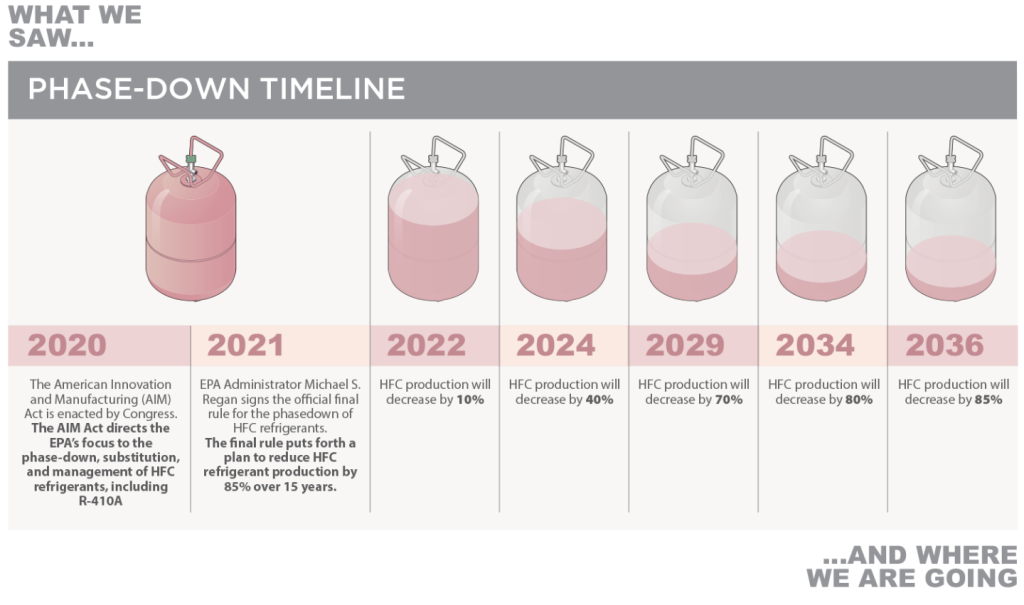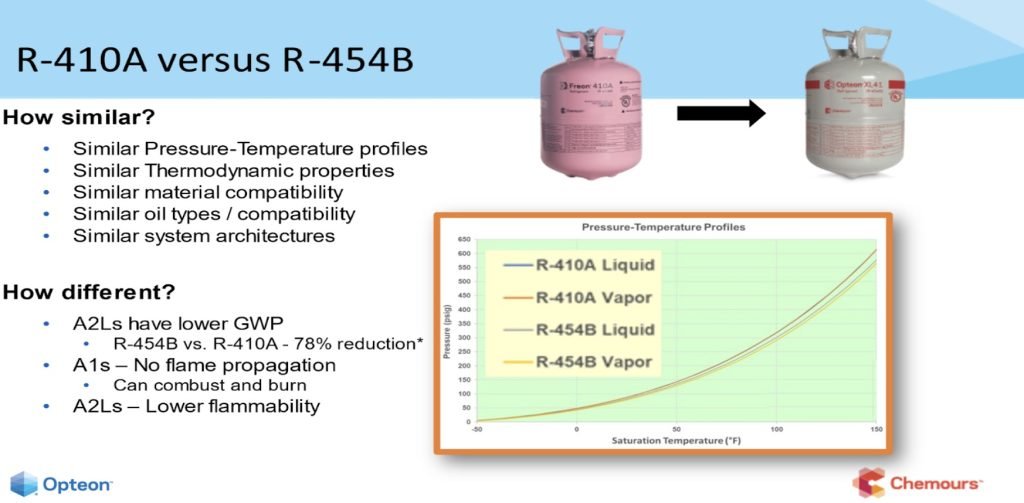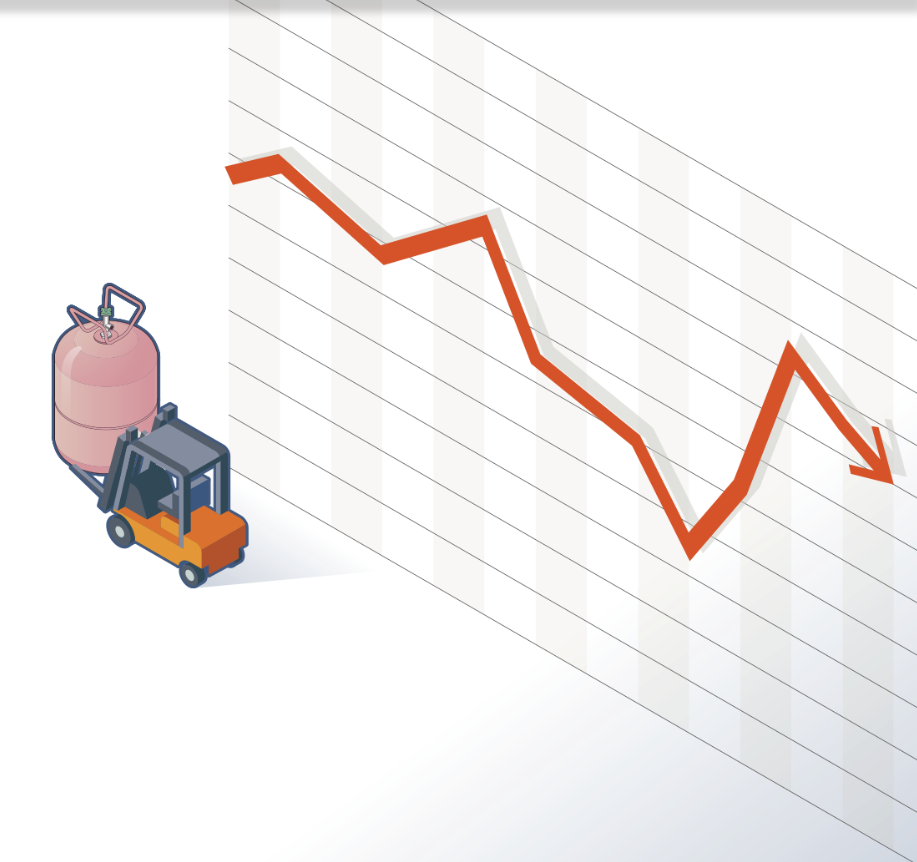Get Tech Tips
Subscribe to free tech tips.
R-410A Phase-Down Update

This tech tip is an overview of the livestream by the same name, featuring HVAC School contributors Matt Bruner, Roman Baugh, and Adam Mufich, as well as special guests Don Gillis, Dr. Chuck Allgood, and Jason Obrzut. You can watch the full livestream HERE. These gents also gave the “Flammable Refrigerant Update” at the 2023 HVACR Training Symposium, which you can watch HERE.
We’ve been talking about the HFC phase-down for a few years: A2Ls are coming, and R-410A is being phased down by 85% through 2036 (but not outright banned). However, the EPA recently released a final rule with restrictions on manufacturing and installing R-410A equipment, which will affect contractors and consumers. This R-410A phase-down update will go over the AIM Act timeline, the EPA’s recent final rule, and most of the things you need to know about A2Ls as we start seeing them in the field.
AIM Act Timeline
The R-410A phase-down comes from the American Innovation and Manufacturing (AIM) Act, which was signed by the U.S. president in 2020. The EPA didn’t decide to phase down HFCs, but it was the body that set forth a plan to meet the requirements of the AIM Act.
The industry saw the first wave of the phase-down in 2022, where R-410A production decreased by 10%. We are on the heels of the next stage of the phase-down; in 2024, the production and importation of R-410A will fall by another 30%. Production will only be at 60% of its level before 2022.

Credit: The Chemours Company
There are two parts to the EPA’s phase-down process: setting manufacturing limits (for refrigerant producers like Chemours, Honeywell, etc.) and mandating field practices.
Currently, refrigerant manufacturers like Chemours have no legal need to stop making R-410A. This phase-down isn’t like the R-22 phaseout we saw in 2020, where production stopped completely. Instead, the EPA gradually issues lower production allowances to these manufacturers until we reach that 85% phase-down target. Refrigerant manufacturers may stop producing R-410A when the demand for the refrigerant no longer requires new R-410A to keep entering the market.
Many of the field practices that will be mandated involve leak detection (and installing sensors), restrictions on installing new equipment, and leak repair. These have yet to go into effect and will be covered in greater detail later in this tech tip.
Training & Certification
As of right now, there will be no new training or certifications required for technicians to work on systems with A2L refrigerants. Technicians will only need their usual EPA 608 certification. However, the EPA is now accepting comments about training requirements on a proposed rule (link to section VIII of the proposed rule). You can submit a comment on this proposed rule on the regulations.gov website HERE.
Similarities Between A1s and A2Ls
Unlike the shift from R-22 to R-410A, we’ll start using refrigerants that have chemical properties that are very similar to R-410A.

Credit: The Chemours Company
The discharge temperatures of R-32 will be a little higher and call for a thicker oil (POE-46), but the system pressures, temperatures, and efficiencies are all very similar. R-454B will use the same oil as R-410A: POE-32. Don Gillis wrote an article about oil best practices for these refrigerants, which you can read HERE.
We can also use the same metals to manufacture and install systems. These A2L refrigerants don’t react harmfully with copper or anything like that, so we can reuse line sets (as long as those line sets comply with things like the manufacturer’s long lines guidelines).
Despite the similarities, it will be illegal to retrofit A1 systems to accommodate A2L refrigerants. We can never change flammability classes when we retrofit systems.
A1 vs. A2L Flammability
Most of the misunderstandings around A2L refrigerants deal with their flammability. While we think of A1s like R-22 and R-410A as “non-flammable,” that’s not actually true.
Refrigerants are tested in a lab under specific testing conditions. To be classified as an A1, a refrigerant must produce a flame that stays within a 90-degree angle. A2L refrigerants are just outside that 90-degree angle. From a flammability standpoint, A2Ls are much more similar to A1s (like R-22 and R-410A) than A2s.
In a house fire, both A2Ls and A1s would most likely combust, but the mild flammability of A2Ls won’t be that much different from working with A1 refrigerants. There are absolutely no hydrocarbons (like propane or R-290) in A2L refrigerants or refrigerant blends; that’s a common misconception.
You can see the different flammability ratings in action (A1, A2L, A2, and A3) in one of ESCO’s “Did You Know?” webcasts. It’s available on the ESCO Institute YouTube channel and the HVACR Learning Network. The HVACR Learning Network offers free viewing to everyone and the opportunity to earn NATE credits.
Details of EPA Final Rule
The EPA published its final rule on October 24th, 2023. This rule contains restrictions on the use of HFCs starting in 2025. Self-contained HVAC systems using R-410A will no longer be manufactured or imported after January 1st, 2025, but there is a three-year sell-through period. Self-contained or packaged units can be sold, exported, and installed through January 1st, 2028.
At this time, split systems, defined as “field-assembled” systems in the final rule, can no longer be installed after January 1st, 2025. Some people and groups in the trade, including HARDI, are petitioning the EPA to make split systems follow the same timeline as packaged systems, allowing for a longer sell-through period.
VRF/V systems will have an installation ban after January 1st, 2026, and most industrial-process chillers similarly have sell-through periods. (Some chillers can be installed through January 1st, 2026, others by January 1st, 2028. The dates vary by application and exit fluid temperature.)
Regardless of what happens, manufacturing and installing individual components of split systems will be allowed indefinitely. You can replace compressors, TXVs, and even condensing units of R-410A systems needing repairs.
Wait! Can’t We Install Multiple “Components” as Systems?
Things can get a little tricky with the components, and it won’t be practical (or legal) to install multiple parts—manufactured and sold as components—as a complete system.
It would be a violation to install a new evaporator and new condenser and treat it as a system install, but that’s not the only thing that makes things complicated. The differing warranties for parts and systems would make it impractical (even if the law didn’t already).
Some components may also have to be dry-charged with nitrogen instead of refrigerant if the R-410A prices increase. Getting the R-410A refrigerant and field-charge the system may be more difficult and expensive.
M1 efficiency regulations set forth by the Department of Energy (DOE) can also make replacing condensers in older systems harder. Anything we install must comply with the DOE regulations—the same ones that brought us SEER2. To learn more about how a manufacturer (Rheem) has approached the M1 efficiency regulations and SEER2, you can watch this HVACR Learning Network video (again, with an option to earn NATE credits).
A2L-Rated Tools and Tanks
All the hand tools you’ve been using on A1 systems will be safe for A2L systems. These include wrenches, flaring tools, copper bending tools, and more.
However, vacuum pumps and recovery machines must be rated for use on A2Ls. In these tools, refrigerant may be in direct contact with components of the tool that spark. Many of the most recent models have been approved for A2Ls; you just have to look up your equipment model number to make sure your machines are rated for A2Ls. As you look to replace broken tools, make sure they are forward-compatible.
If you’re unsure if your tool is A2L-rated, you can see if it’s on this list from TruTech Tools. If you have questions about a specific tool, you can always research it online or call the manufacturer.
Here is a list of common tool brands with links to some relevant information about A2L compatibility:
A2L tanks will also have left-handed threads to reduce the possibility of someone mistaking them for A1 refrigerant tanks. It’s best practice to transport these tanks upright and secured, but they have built-in relief valves to keep them from bursting in emergencies. You will still be able to transport up to 440 pounds of A2L refrigerants in pressurized tanks on your truck, too.
Work Area Clearances for A2L Systems
The recommended working area clearance for residential A2L systems is 10 feet. That number could be as high as 25 feet for some larger systems.
You will work on (or install) some air handlers in closets that don’t have a clearance of 10 feet, which may worry some technicians. The good news is that the work area clearance isn’t enforceable; it’s a recommendation.
The real purpose of the work area clearance is to keep other people away from the unit while you’re working on it. This guideline reduces the risk of ignition sources, like a homeowner’s lit cigarette, from entering the work area.
Personal Protection
When working in a tight space, you will always want to make sure you have adequate ventilation. This advice is true of all refrigerants, not just A2Ls. Any refrigerant, including A1s, can pose an asphyxiation risk in a tight area without any form of ventilation. (Refrigerant is heavier than air and can fill a room from the bottom up.)
However, there are no special PPE requirements just for A2Ls.
Recovering and Reclaiming R-410A

Reclamation will become a lot more important as the phase-down continues. The law only ramps down the production of new R-410A, not existing R-410A.
As virgin refrigerant becomes costlier and harder to come by, recovered and reclaimed refrigerant will be available to bridge the gap between supply and demand. That also means that there will be value in submitting refrigerant for reclamation.
A2L Leak Protocols and Leak Detection Sensors
When A2L equipment comes with a leak detection sensor, you can expect that to come with the system factory-installed. You may need to change the position of the sensor on the coil depending on the airflow direction (such as in a heat pump or furnace).
Most likely, the sensor will be a plug that goes into the main board and energizes G when it detects a preset PPM of refrigerant (depending on the OEM). Energizing G turns the blower on to clear out the concentration of leaked refrigerant.
Then, Y will be de-energized, shutting the system down at the contactor. The entire cycle lasts for about 5 minutes before monitoring the area around the sensor again. It will take multiple of these cycles to cause the unit to shut down indefinitely. Many of these sensors will use infrared sensing technology.
The sensors will keep shutting the system down if you recharge the system and walk away, so they’ll require you to fix evaporator coil leaks.
ASHRAE Standard 15.2 Informative Appendix B: B4–B4.2.1 also recommends that you record the date of service on the equipment label anytime you open the refrigerant circuit of a piece of A2L equipment. Needing to charge a system more than once per three years indicates a leak, so those records are important for determining if a system is leaking.
R-410A Leak Repair Requirements
The EPA’s final rule also introduced leak repair requirements for any system carrying over 15 pounds of an HFC refrigerant.
Within 60 days of the final rule (i.e., within the next week or so), we will be required to repair leaks on systems containing 50 or more pounds of an HFC refrigerant or substitute with a GWP greater than 53.
Within one year of the final rule, the criteria will include systems containing 15–50 pounds of an HFC refrigerant or substitute with a GWP above 53. Most residential equipment won’t be affected, but some larger systems may require leak repairs under this rule.
Conclusion
We’ve recently seen several changes with the latest EPA final rule, which may put economic pressure on smaller contractors and low-income consumers. As far as we’re concerned with using A2Ls, there won’t be a massive change in our system temperatures and pressures.
We may have to replace a few older recovery machines and vacuum pumps, making sure everything in our arsenal is A2L-rated, but we can hold on to most of the tools we all know and love. There are a few changes to A2L tanks, such as the introduction of left-handed threads and a pressure-relief valve, but we won’t have to revamp most of our processes.
And remember: A2Ls are far closer to A1s than A3s (like propane). There is no propane in A2L refrigerants.
Resources
If you want to stay aware of the EPA’s rulings, you can read copies of its legal documents in the federal register. The federal register is the hub for all public documents across federal agencies.
The EPA’s most recent final rule about the HFC phase-down is available in its entirety HERE. There are also several simplified versions of the document. (This ACHR News article gives a good overview based on this fact sheet published by the EPA.) You can also visit the EPA’s FAQ page for the recently finalized rule for sector-based restrictions HERE.
You can also learn more about R-454B (Opteon XL41 by Chemours) on the Opteon website. We also recommend checking out ESCO Institute’s HVACR Learning Network, which contains several courses and webinars. Some are free, some provide NATE credits, and all are great for learning more about the trade—news, science, best practices, and more.











Comments
To leave a comment, you need to log in.
Log In